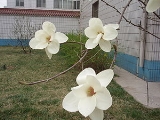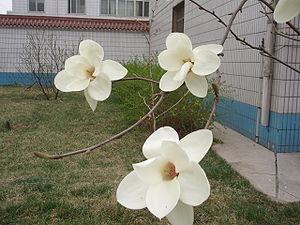
Magnoliopsida
Encyclopedia
Magnoliopsida is a valid botanical name
for a class
of flowering plant
s. By definition the class will include the family Magnoliaceae
, but its circumscription can otherwise vary, being more inclusive or less inclusive depending upon the classification system being discussed.

and the Cronquist system
the name was used for the group known as dicotyledons.
used this internal taxonomy:
used this internal taxonomy (in the 1981 version):
and the Thorne system (1992)
used the name Magnoliopsida for the flowering plants (angiosperms). However, the Cronquist system has been very popular and there have been many versions of the system published. In some of these Cronquist-based systems the name Magnoliopsida (at the rank of class) refers to the flowering plants (the angiosperms).
used the name Magnoliopsida for a group of the primitive dicotyledons, corresponding to about half of the plants in the magnoliids:
and APG II system
s botanical names are used only at the rank of order and below. Above the rank of order, these systems use their own names, such as angiosperms, eudicots
, monocots, rosids
, etc. These names refer to clade
s (unranked). This class Magnoliopsida is not defined. Note that the idea that dicotyledons could be a taxonomic unit and get a formal name is rejected by the APG: the dicots are considered to be paraphyletic.
Botanical name
A botanical name is a formal scientific name conforming to the International Code of Botanical Nomenclature and, if it concerns a plant cultigen, the additional cultivar and/or Group epithets must conform to the International Code of Nomenclature for Cultivated Plants...
for a class
Class (biology)
In biological classification, class is* a taxonomic rank. Other well-known ranks are life, domain, kingdom, phylum, order, family, genus, and species, with class fitting between phylum and order...
of flowering plant
Flowering plant
The flowering plants , also known as Angiospermae or Magnoliophyta, are the most diverse group of land plants. Angiosperms are seed-producing plants like the gymnosperms and can be distinguished from the gymnosperms by a series of synapomorphies...
s. By definition the class will include the family Magnoliaceae
Magnoliaceae
The Magnoliaceae, or Magnolia Family, is a flowering plant family in the order Magnoliales. It consists of two subfamilies:*Magnolioideae, of which Magnolia is the most well-known genus....
, but its circumscription can otherwise vary, being more inclusive or less inclusive depending upon the classification system being discussed.

Cronquist and Takhtajan systems
In the Takhtajan systemTakhtajan system
A system of plant taxonomy, the Takhtajan system of plant classification was published by Armen Takhtajan, in several versions from the 1950s onwards. It is usually compared to the Cronquist system. Key publications:-External links:* Takhtajan system at...
and the Cronquist system
Cronquist system
The Cronquist system is a taxonomic classification system of flowering plants. It was developed by Arthur Cronquist in his texts An Integrated System of Classification of Flowering Plants and The Evolution and Classification of Flowering Plants .Cronquist's system places flowering plants into two...
the name was used for the group known as dicotyledons.
Magnoliopsida in the Takhtajan system
The Takhtajan systemTakhtajan system
A system of plant taxonomy, the Takhtajan system of plant classification was published by Armen Takhtajan, in several versions from the 1950s onwards. It is usually compared to the Cronquist system. Key publications:-External links:* Takhtajan system at...
used this internal taxonomy:
- class Magnoliopsida [= dicotyledons]
- subclass MagnoliidaeMagnoliidaeMagnoliids are a group of about 9,000 species of flowering plants, including magnolias, nutmeg, bay laurel, cinnamon, avocado, black pepper, and many others. They are characterized by trimerous flowers, pollen with one pore, and usually branching-veined leaves.-Classification:Traditionally,...
- subclass Nymphaeidae
- subclass Nelumbonidae
- subclass RanunculidaeRanunculidaeRanunculidae is a subclass of plants used in some taxonomic systems and not others. By necessity it includes the order Ranunculales, but otherwise it differs between taxonomic systems....
- subclass CaryophyllidaeCaryophyllidaeCaryophyllidae is a botanical name at the rank of subclass. At the moment there is no complete consensus about what orders it includes, except that it presumably contains the order Caryophyllales...
- subclass HamamelididaeHamamelididaeHamamelididae is a botanical name at the rank of subclass. A well-known system that used this name is the Cronquist system, although in the disallowed spelling Hamamelidae...
- subclass DilleniidaeDilleniidaeDillenidae is a botanical name at the rank of subclass....
- subclass RosidaeRosidaeUnder the International Code of Botanical Nomenclature , Rosidae is a botanical name at the rank of subclass. Circumscription of the subclass will vary with the taxonomic system being used; the only requirement being that it includes the family Rosaceae....
- subclass Cornidae
- subclass AsteridaeAsteridaeAsteridae is a clade of plants, known for their flowers. Asteridae has been ranked as a subclass, but this ranking has varied depending on the taxonomy being used...
- subclass Lamiidae
- subclass Magnoliidae
Magnoliopsida in the Cronquist system
The Cronquist systemCronquist system
The Cronquist system is a taxonomic classification system of flowering plants. It was developed by Arthur Cronquist in his texts An Integrated System of Classification of Flowering Plants and The Evolution and Classification of Flowering Plants .Cronquist's system places flowering plants into two...
used this internal taxonomy (in the 1981 version):
- class Magnoliopsida [= dicotyledons]
- subclass MagnoliidaeMagnoliidaeMagnoliids are a group of about 9,000 species of flowering plants, including magnolias, nutmeg, bay laurel, cinnamon, avocado, black pepper, and many others. They are characterized by trimerous flowers, pollen with one pore, and usually branching-veined leaves.-Classification:Traditionally,...
- subclass Hamamelidae
- subclass CaryophyllidaeCaryophyllidaeCaryophyllidae is a botanical name at the rank of subclass. At the moment there is no complete consensus about what orders it includes, except that it presumably contains the order Caryophyllales...
- subclass DilleniidaeDilleniidaeDillenidae is a botanical name at the rank of subclass....
- subclass RosidaeRosidaeUnder the International Code of Botanical Nomenclature , Rosidae is a botanical name at the rank of subclass. Circumscription of the subclass will vary with the taxonomic system being used; the only requirement being that it includes the family Rosaceae....
- subclass AsteridaeAsteridaeAsteridae is a clade of plants, known for their flowers. Asteridae has been ranked as a subclass, but this ranking has varied depending on the taxonomy being used...
- subclass Magnoliidae
Dahlgren and Thorne systems
The Dahlgren systemDahlgren system
One of the modern systems of plant taxonomy, the Dahlgren system was published by monocot specialist Rolf Dahlgren. His wife Gertrud Dahlgren carried on after his death.According to the extensive listing by Professor Reveal One of the modern systems of plant taxonomy, the Dahlgren system was...
and the Thorne system (1992)
Thorne system (1992)
A modern system of plant taxonomy, the Thorne system of plant classification was drawn up by the botanist Robert F. Thorne . He replaced it in 2000 with a new system. These two systems were published in:...
used the name Magnoliopsida for the flowering plants (angiosperms). However, the Cronquist system has been very popular and there have been many versions of the system published. In some of these Cronquist-based systems the name Magnoliopsida (at the rank of class) refers to the flowering plants (the angiosperms).
- class Magnoliopsida [= angiosperms]
- subclass MagnoliidaeMagnoliidaeMagnoliids are a group of about 9,000 species of flowering plants, including magnolias, nutmeg, bay laurel, cinnamon, avocado, black pepper, and many others. They are characterized by trimerous flowers, pollen with one pore, and usually branching-veined leaves.-Classification:Traditionally,...
[= dicotyledons] - subclass LiliidaeLiliidaeLiliidae is a botanical name at the rank of subclass. Circumscription of the subclass will vary with the taxonomic system being used ; the only requirement being that it includes the family Liliaceae....
[= monocotyledons]
- subclass Magnoliidae
Reveal system
The Reveal systemReveal system
A modern system of plant taxonomy, the Reveal system of plant classification was drawn up by the botanist J.L. Reveal , professor emeritus at the Norton Brown Herbarium, Maryland .The last update of the system was made in 1999...
used the name Magnoliopsida for a group of the primitive dicotyledons, corresponding to about half of the plants in the magnoliids:
- class 1. Magnoliopsida
- superorder 1. Magnolianae
- superorder 2. Lauranae
APG systems
In the APGAPG system
The APG system of plant classification is the first, now obsolete, version of a modern, mostly molecular-based, system of plant taxonomy that was published in 1998 by the Angiosperm Phylogeny Group. It was superseded in 2003 by a revision, the APG II system, and then in 2009 by a further...
and APG II system
APG II system
The APG II system of plant classification is the second, now obsolete, version of a modern, mostly molecular-based, system of plant taxonomy that was published in April 2003 by the Angiosperm Phylogeny Group. It was a revision of the first APG system, published in 1998, and was superseded in 2009...
s botanical names are used only at the rank of order and below. Above the rank of order, these systems use their own names, such as angiosperms, eudicots
Eudicots
Eudicots and Eudicotyledons are botanical terms introduced by Doyle & Hotton to refer to a monophyletic group of flowering plants that had been called tricolpates or non-Magnoliid dicots by previous authors...
, monocots, rosids
Rosids
The rosids are members of a large clade of flowering plants, containing about 70,000 species, more than a quarter of all angiosperms. The clade is divided into 16 to 20 orders, depending upon circumscription and classification. These orders, in turn, together comprise about 140 families...
, etc. These names refer to clade
Clade
A clade is a group consisting of a species and all its descendants. In the terms of biological systematics, a clade is a single "branch" on the "tree of life". The idea that such a "natural group" of organisms should be grouped together and given a taxonomic name is central to biological...
s (unranked). This class Magnoliopsida is not defined. Note that the idea that dicotyledons could be a taxonomic unit and get a formal name is rejected by the APG: the dicots are considered to be paraphyletic.

